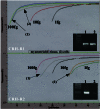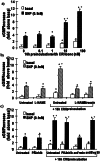Up-regulation of nitric oxide synthase and modulation of the guanylate cyclase activity by corticotropin-releasing hormone but not urocortin II or urocortin III in cultured human pregnant myometrial cells
- PMID: 11854458
- PMCID: PMC122513
- DOI: 10.1073/pnas.052296399
Up-regulation of nitric oxide synthase and modulation of the guanylate cyclase activity by corticotropin-releasing hormone but not urocortin II or urocortin III in cultured human pregnant myometrial cells
Abstract
The biological actions of corticotropin-releasing hormone (CRH) in the human myometrium during pregnancy and labor are unknown. We hypothesized that CRH may modulate the nitric oxide system, and influence myometrial relaxation/contractility. Incubation of myometrial cells with CRH, but not urocortin II or urocortin III, for 8-16 h significantly induced mRNA and protein expression of endothelial and brain but not inducible nitric oxide synthase (NOS) isoforms. This action resulted in increased activity of soluble guanylate cyclase (GC(s)), demonstrated by the enhanced cGMP-producing capacity of the NO donor, sodium nitroprusside. CRH also caused acute activation of the membrane-bound GC, shown by increased basal or atrial natriuretic peptide (ANP)-stimulated cGMP production. These effects appeared to be mediated via the R1 receptors because the CRH receptor antagonists, astressin and antalarmin but not anti-sauvagine 30, could block them. The acute effects of CRH were significantly reduced by inhibition of protein kinase A (PKA) activity, suggesting it is partially PKA dependent. Activation of protein kinase C (PKC) resulted in significant inhibition of both ANP-and CRH-stimulated cGMP production, suggesting a direct effect of PKC on membrane-bound GC. In conclusion, CRH appears to have a dual effect on myometrial NOS/GC pathway, a short term effect predominantly mediated by PKA, and a long-term effect increasing constitutive NOS expression, mediated by a PKA-independent mechanism. This mechanism could potentially be active during human pregnancy, and, because cGMP stimulates myometrial relaxation, these findings further suggest that during pregnancy CRH primarily activates intracellular signals that contribute to the maintenance of myometrial quiescence.
Figures







References
-
- Grammatopoulos D K, Hillhouse E W. Lancet. 1999;354:1546–1549. - PubMed
-
- Grammatopoulos D, Dai Y, Chen J, Karteris E, Papadopoulou N, Easton A J, Hillhouse E W. J Clin Endocrinol Metab. 1998;83:2539–2544. - PubMed
-
- Hillhouse E W, Grammatopoulos D, Milton N, Quartero H. J Clin Endocrinol Metab. 1993;76:736–741. - PubMed
-
- Stevens M Y, Challis J R, Lye S J. J Clin Endocrinol Metab. 1998;83:4107–4115. - PubMed
-
- Grammatopoulos D, Milton N, Hillhouse E W. Mol Cell Endocrinol. 1994;99:245–250. - PubMed
Publication types
MeSH terms
Substances
Grants and funding
LinkOut - more resources
Full Text Sources
Molecular Biology Databases
Miscellaneous

